|
We left Golfito with a new crew, Dave Wyman, a friend with Canal experience, & the Surbeck's, who were to make the Atlantic crossing with us. This leg of the trip was planned to be a chance for the Surbeck's to become familiar with the boat to get ready for the North Atlantic crossing. As it turned out the Surbecks left the boat in Colon after transiting the canal.
Our departure from K&B Marina was less eventful than our
arrival. Everything went smoothly except that once heading out we discovered
one fender still hanging that should have been removed at the dock. It was on
the side that we have no walk around. Since we had a long trip ahead of us we
decided we wanted it stowed. Larry killed the props and I carefully walked the
small ledge on the side of the boat where there is no gangway. Margie secured a
rope from the deck above for me to hang onto while I untied the fender and
Richard scooted his way out to within reach so I could had the fender to him
with my one free arm and he could throw it back into the cockpit. We worked as
a team but decided we need to do better job getting lines and fenders off on the
next departure.
ISLA SECAS We had a smooth overnight cruise to Isla Secas. The small
group of islands is not charted for anchorage so we got a waypoint from the
Island caretaker. We know the new owners of the islands which we won’t mention
their names to maintain their privacy. Isla Seca means “Dry Islands”. They are
building what I’d call an eco lodge with guest rooms constructed of Kurts. As
we slowly came in over their coral reef we anchored at the designated waypoint.
There were two other sailboats at the anchorage and as came around them to get
to our spot we crossed over a sudden shallow area, which was the coral shelf.
We hailed the caretaker on the radio and were greeted by
her very cheerful voice. She had seen us arrive and was waiting to hear from
us. We got the dinghy down and headed in to tie up at their new portable
fiberglass dinghy dock which lead up to a finely built palapa covered concrete
landing. Linda was standing under the shade of the palapa waiting to great us.
Lind was younger than I expected to be alone except for the workers living on
these islands. She managed the day-to-day activity of this project. She was so
gracious and gave us a spectacular tour of the settlement. There were a few
guest Kurts strategically scattered throughout. You reached each one by walking
through a cleared path laden with shells and bits of coral and rock. The dirt
was a rich red. The path protected you from the staining of the rich red earth
and more importantly the mud during the rains. The islands were a tropical
paradise. There were beautiful palms, and clean beaches strewn with shells and
hermit crabs. Tropical fruit trees abound. All the new construction is being
done with the ecology and landscape of the island in mind. Linda was telling us
that there was an original resident villager that had lived alone on the islands
20 years after his parents died.
The day we arrived, they were digging a well for water.
This really isn’t a dry island, as they have plenty of well water. We were
impressed with the perfectly round hole he was digging. It must have been 20
feet deep and 3 /12 feet diameter and perfectly round as if done by a machine.
Maybe these people have a knack for making those round stone spheres without
sophisticated instruments after all. The water that comes from the wells is
treated and is perfectly pure and safe for drinking. The Kurts were wonderfully decorated with soft taupe
colors, wicker furniture, palm tree covered matelasses on the beds and modern
bathrooms with all the conveniences. I imagined staying in one, away from
civilization and the noise of freeways and light pollution. Only the sound of
the beach. In the day you could wander the island and swim in the pure clean
water, snorkeling, and then walk the beaches gathering shells and watching the
hermit crabs. The fruits growing on the island were abundant. I have to hand it to the owners for doing this project the
right way, protecting nature and working within the environment.
BAHIA HONDA
Again, we had an easy few hour cruise to the protected bay
of Bahia Honda. We could have anchored at Isla Secas but the area is exposed
and the winds can come from all directions so we decided we wanted to be in a
calm setting for the evening because we had a long haul to Panama City ahead of
us. Also, heading south from this point to Panama City is said to be “brutal”
by captain Rains. Everyone on board said it was going to be “no problem” but I
trusted Capt Rains and all that he had said prior had been right on. I kept it
the back of my mind. The landscape in Panama is very tropical and the green hills are dotted with smoke funnels coming up out of the jungle as they burn the cane fields. We passed a remote mansion on an islet next to the coastline with a huge mega fast yacht docked at their private yacht. We had fun imagining a drug lord living there, as we are getting closer to that part of the world, it was plausible but not likely. We entered the huge Bahia Honda and I felt like Columbus discovering a new virgin land. The bay is huge and no development. It is the perfect harbor for a huge city but none can be found. There was only a very small village with huts elevated over the water covered in palm fronds and wooden canoes beached below them. We spotted a singular catamaran beached. Linda, from Isla Secas, said one of her workers was here for a couple days so he could beach his catamaran to get the bottom cleaned and painted. Guess that was he. The only other building we saw was a big home on the shore, of course built by some “American”, destroying the serenity of the place, with over cleared space and structures bigger than need be.
It was not long before Ziggy alerted us to a couple of
villagers that were approaching the boat in their dugout canoe. Their dark
leathery faces and broad smiles exposing their missing teeth were our greeting. The older guy had character written all over him and he gave us a big wave wide
smile. We had heard from other cruisers that the Panamanians were a talkative
bunch. Guess it’s true. This old guy started a spiel like you wouldn’t
believe. Dave and I stood on the cockpit and talked with him in Spanish. He
talked about politics and the surrounding area. We learned the big home by our
boat was owned by an American from Colorado named Bush and he came and went in a
helicopter.
Later, at dusk, another guy paddled out his small dugout.
Ziggy let us know about his arrival too. This guy mostly wanted to chitchat.
Talking about life though worlds apart.
So long my friend....
PUNTA MALAWe left at the crack of dawn.
Sure enough at noon, when Margie and I took watch and it
began. The seas just got increasingly worse. As it was explained to me, the
currents swirl around as they reach the canal (or Bay of Panama) and whip back
while the winds become strong as the mountains flatten out. The winds come from
the Caribbean and create havoc with the strong swirling currents.
Well, this was the worst sea yet on the trip. This time I
couldn’t hide in the belly of the boat with Ziggy but had to rough it out on
watch like everybody else. You literally had to put your feet on the dash to
hold yourself into the helm seat as the boat crashed into each huge wave. The
winds were 30 knots and thereabout and the waves were ranging from 6-8-10. We
had a strong current because our speed was way above normal. We had to slow the
boat down at times to counteract the boat slamming after each large wave. When
off watch, you couldn’t get rest, as you had to use every part of your body to
hold on, every moment. Things were banging and sliding and we were busy
wrapping things in towels and stowing things that were lose. It was twelve
hours of this. It was grueling or “brutal” as John Rains predicted. People
were getting grouchy and some refused to go down into the hot engine room for
their hourly check. Maybe it would put them over the edge for upchucking the
tuna casserole who said they hoped they wouldn’t have the enjoy the casserole a
second time? By dawn or a bit earlier it calmed down quite a
bit but the winds were still strong. We lost 2-3 hours fighting the wind and
seas and approached Panama City later than we expected. We were on edge all
night, watching for the many freighters on our radar that were headed for the
canal. Though no shipping lanes are marked on the charts we stayed close to
shore to avoid them. We had no visibility and could only track them on radar
with the marpa. Sometimes we’d have four or five ships tracking at the same
time. We had two radars going the whole time tracking a 6-mile range and
12-mile range. If we saw an object we’d locate it on the radar and lock it in
and tract it’s direction, speed and bearing to make sure we weren’t on a
collision course. The whole experience went smoothly but bumpy.
|
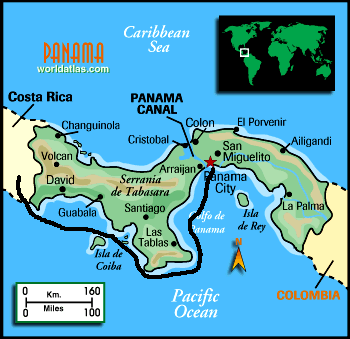 GOLFITO to PANAMA CITY
GOLFITO to PANAMA CITY 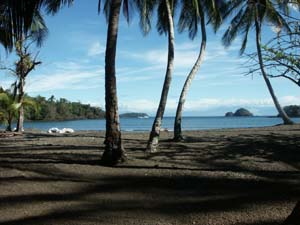 I’m sure all the other
yachters had a great time watching us
doing this trapeze act as well as the three tries getting into the dock when we
arrived. Makes for good watching, as you all know that own a boat.
I’m sure all the other
yachters had a great time watching us
doing this trapeze act as well as the three tries getting into the dock when we
arrived. Makes for good watching, as you all know that own a boat.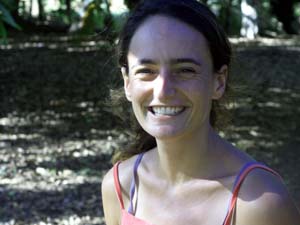 Luckily we arrived at high tide and anchored in the deeper water between the two
boats.
Luckily we arrived at high tide and anchored in the deeper water between the two
boats. 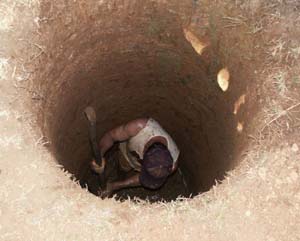 The new owners didn’t want to dislocate him so
they built him a house on the point so that he could continue to stay. Linda
said that since they have 30 workers on the island now, he has fallen in love
with one and prefers to sleep in a tent with her on the main island. Linda says
her day sometimes will require ten miles of walking to get from on side of the
island to the other. It’s been particularly difficult because of that and
trying to transport things from one side to another without heavy machinery.
The new owners didn’t want to dislocate him so
they built him a house on the point so that he could continue to stay. Linda
said that since they have 30 workers on the island now, he has fallen in love
with one and prefers to sleep in a tent with her on the main island. Linda says
her day sometimes will require ten miles of walking to get from on side of the
island to the other. It’s been particularly difficult because of that and
trying to transport things from one side to another without heavy machinery.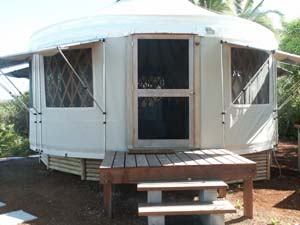
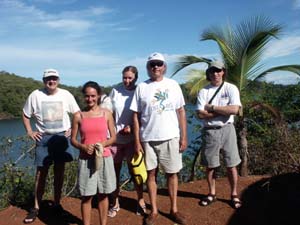 It was like a
dream haven. What a spectacular place this is and will be for someone who wants
to escape the hectic world. Stranded on a tropical paradise.
It was like a
dream haven. What a spectacular place this is and will be for someone who wants
to escape the hectic world. Stranded on a tropical paradise.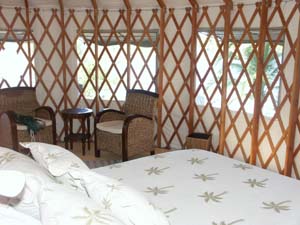 Linda is truly
a pioneering woman also, living here for the last three years diligently dealing
with the demands of nature and lack of modern equipment and conveniences.
Spectacular! Yachters up and down the coast have noticed the few Kurts going up
and are all curious about what’s going on. There are various rumors about a man
from Washington who owns it, etc. It’s comical to hear the stories and how
exaggerated they are when we have been fortunate enough to have heard their
plans from the horses mouth.
Linda is truly
a pioneering woman also, living here for the last three years diligently dealing
with the demands of nature and lack of modern equipment and conveniences.
Spectacular! Yachters up and down the coast have noticed the few Kurts going up
and are all curious about what’s going on. There are various rumors about a man
from Washington who owns it, etc. It’s comical to hear the stories and how
exaggerated they are when we have been fortunate enough to have heard their
plans from the horses mouth.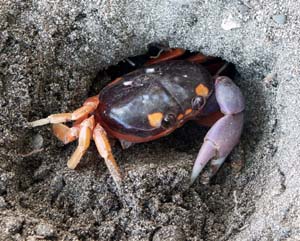 Unfortunately, we didn’t have much time to spend because
the tide was going out and we had to get us all back to the boat before
Unfortunately, we didn’t have much time to spend because
the tide was going out and we had to get us all back to the boat before
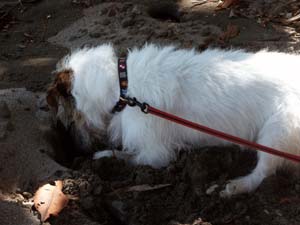 it was
to shallow for the dinghy. The waters surrounding the islands are noted for
their coral reefs, good snorkeling and sharks. Linda assured us in all her
three years of diving and snorkeling she has seen no sharks so it is probably a
myth. We were so hot when we got back that we didn’t care if there were rumors
of sharks. We dove in the turquoise water for a refreshing swim and a bit of
snorkeling before heading for our night anchorage in Bahia Honda.
it was
to shallow for the dinghy. The waters surrounding the islands are noted for
their coral reefs, good snorkeling and sharks. Linda assured us in all her
three years of diving and snorkeling she has seen no sharks so it is probably a
myth. We were so hot when we got back that we didn’t care if there were rumors
of sharks. We dove in the turquoise water for a refreshing swim and a bit of
snorkeling before heading for our night anchorage in Bahia Honda.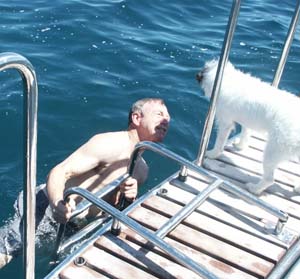 As we cruised south we passed Isla Coiba, one of the many
islands scattered in this area. We were amused to read in our book that this
particular island has a penal colony on it. Apparently, in recent years,
environmentalists discovered that 82% of this island is covered in virgin
forest, so the government has been making an effort to remove the prisoners from
the island. The evacuation should almost be completed by now, but the books
warn cruisers never to pick up people swimming or drifting on rafts in this area
as the prisoners are always trying to make an escape. It is said that not too
long ago a yacht was boarded and the cruisers murdered by the escaped convicts.
You are also advised to keep night watches at anchorages in the nearby area.
As we cruised south we passed Isla Coiba, one of the many
islands scattered in this area. We were amused to read in our book that this
particular island has a penal colony on it. Apparently, in recent years,
environmentalists discovered that 82% of this island is covered in virgin
forest, so the government has been making an effort to remove the prisoners from
the island. The evacuation should almost be completed by now, but the books
warn cruisers never to pick up people swimming or drifting on rafts in this area
as the prisoners are always trying to make an escape. It is said that not too
long ago a yacht was boarded and the cruisers murdered by the escaped convicts.
You are also advised to keep night watches at anchorages in the nearby area.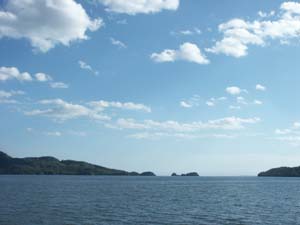
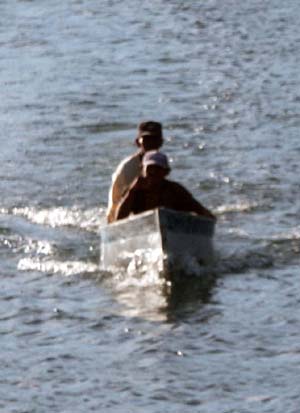 There are no roads into this area. You must reach this
area by boat or helicopter because the nearby mountains create a protected
barrier from the outside world. The bay was weather protected and flat, no
swells. We anchored in a nice depth of 40 feet and settled in for an afternoon
of reading and resting.
There are no roads into this area. You must reach this
area by boat or helicopter because the nearby mountains create a protected
barrier from the outside world. The bay was weather protected and flat, no
swells. We anchored in a nice depth of 40 feet and settled in for an afternoon
of reading and resting.
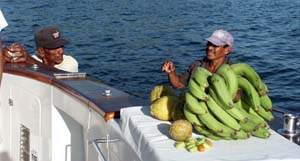
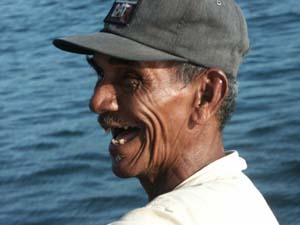 He was rich an owned much of the surrounding land. He said the
other mansion further up the coast (that we playfully imagined was owned by a
drug lord) was owned by an Italian who also came and went by helicopter.
Domingo, was our leathery friend’s name. He said he’s been greeting cruisers
that wonder into this bay for over twenty years. He offered his services. He
said he would gladly get us whatever he could. We asked for some bananas,
pineapple and papaya. He and his pal paddled away but returned in a few hours
loaded with bananas, some hot chili peppers and some great bumpy skinned
lemons. He said there were no papayas or pineapple around. He gladly took a
few dollars and asked if we had candy for the children. We found some M&Ms and
made a trade.
He was rich an owned much of the surrounding land. He said the
other mansion further up the coast (that we playfully imagined was owned by a
drug lord) was owned by an Italian who also came and went by helicopter.
Domingo, was our leathery friend’s name. He said he’s been greeting cruisers
that wonder into this bay for over twenty years. He offered his services. He
said he would gladly get us whatever he could. We asked for some bananas,
pineapple and papaya. He and his pal paddled away but returned in a few hours
loaded with bananas, some hot chili peppers and some great bumpy skinned
lemons. He said there were no papayas or pineapple around. He gladly took a
few dollars and asked if we had candy for the children. We found some M&Ms and
made a trade.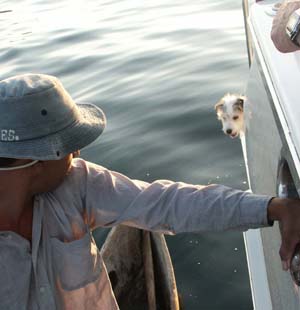
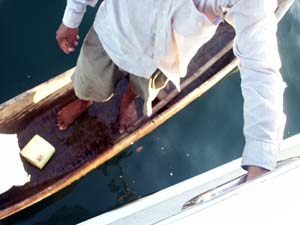 The whole time he was there, he was bailing out his waterlogged dugout with a
plastic cup. We bought two conch shells from him for a couple dollars and
enjoyed chatting with him. It was simple talk, human to human. Though we had
nothing in common with this shoeless young guy in his dirty ragged clothes, we
talked about fishing, the boat and just life in our pigeon Spanish and his
pigeon English. It was these encounters that made this a special place.
The whole time he was there, he was bailing out his waterlogged dugout with a
plastic cup. We bought two conch shells from him for a couple dollars and
enjoyed chatting with him. It was simple talk, human to human. Though we had
nothing in common with this shoeless young guy in his dirty ragged clothes, we
talked about fishing, the boat and just life in our pigeon Spanish and his
pigeon English. It was these encounters that made this a special place.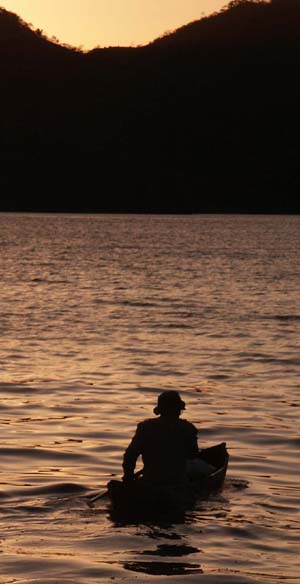
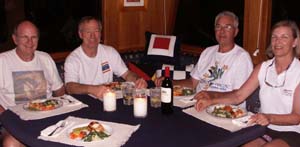 I in the back of my mind
remembering Rains telling me this section was going to be “brutal”. I decided
to make a tuna casserole and cake to have something ready if it got rough,
although everyone poo hoo’ d me. I grumbled to myself, “what a bunch of macho
boaters”. I’m definitely the wimp and always double checking the charts and
depths and rocks and insisting on giving everything a wider berth that the rest
want.
I in the back of my mind
remembering Rains telling me this section was going to be “brutal”. I decided
to make a tuna casserole and cake to have something ready if it got rough,
although everyone poo hoo’ d me. I grumbled to myself, “what a bunch of macho
boaters”. I’m definitely the wimp and always double checking the charts and
depths and rocks and insisting on giving everything a wider berth that the rest
want. 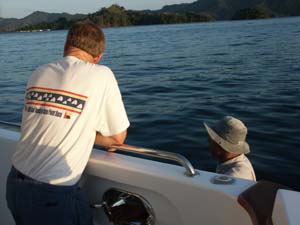
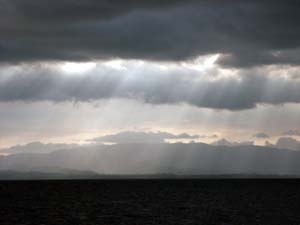
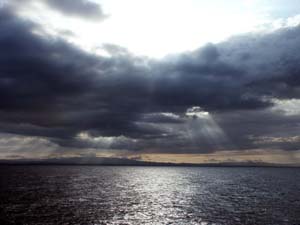 We all worked
together and felt the better for it. It was our first test for what will be
ahead in the Caribbean. We’ve been hearing the horror stories of the strong
winds and seas that we will encounter on our voyage north to Florida. Now
on to
We all worked
together and felt the better for it. It was our first test for what will be
ahead in the Caribbean. We’ve been hearing the horror stories of the strong
winds and seas that we will encounter on our voyage north to Florida. Now
on to